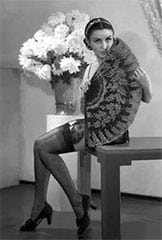VEDETTE
A vedette is a dancer , singer, and actress who performs in a music magazine or variety show. He is, in general, the most important figure in the work .

As can be guessed from its constitution, the word "star" is of French origin, and in its original language it can be understood as the "star of a work". The vedettes do not always bring together the three talents listed in the previous paragraph: there are many examples of women who were exclusively dedicated to singing, such as Celia Gámez . In the same way, there are men who work as vedettes , so it is not an exclusive role for women.
When there are several vedettes in the same show, they are usually numbered according to their importance in the plot: first star , second star , etc. It is important to note that the vedettes are usually accompanied by other dancers, comedians and artists in general.
The first star can also be called a super star , and is the artist with the most important role in a variety show or music magazine.
The vedettes, in general, wear little clothes on stage. Many times they act semi-nude, with suits that reveal their body in almost all its extension. The dress of the vedettes usually includes feathers and various types of accessories.
These women not only act in the theater , but also develop their work in cabarets . In some cases, they become media figures and appear on television programs, fulfilling different functions.
The first stars to rise to fame were various French artists in the first decades of the 20th century . Shortly after, magazine and cabaret-style shows became popular in different Latin American countries , such as Argentina , Mexico and Cuba .
In France, Joséphine Baker stood out , a dancer and singer originally from North America who arrived in Paris in 1925 and soon attracted the attention of the public thanks to her exotic dances and her scant clothing. As is the case in many cases, Baker was more appreciated in Europe than on her own continent, and the success led her to have her own club.
On the other side of the Atlantic Ocean, among the most prominent vedettes in Argentina in the early 1920s was Tita Merello , one of the most important artists in her country, thanks to her talents as a tango singer and actress. Three decades later, the Cuban dancers Amelita Vargas, Rosita Fornés and Blanquita Amaro arrived in Argentina to make history alongside the local stars.
 Many stars emerged in Cuba thanks to the Casino Parisien and the Tropicana cabaret , two important centers where musical magazine shows could be held.
Many stars emerged in Cuba thanks to the Casino Parisien and the Tropicana cabaret , two important centers where musical magazine shows could be held.
For its part, Mexico also saw the birth of many great vedettes since the early 1900s, among which are Lupe Vélez, Mimí Derba, Prudencia Griffel and Amparo Arozamena . In Peru, Analí Cabrera, Amparo Brambilla and Susy Díaz stood out , especially since they began to appear on television in the 1980s.
The figure of the star has also inspired the creation of various fictional characters, such as Lola-Lola (in the film « The Blue Angel «), Roxie Hart (from the film « Chicago «) and Estela Reynolds (one of the characters most memorable of the Spanish television series « La que se avecina «).
It should be noted that the notion of vedette is also used to name the individual who stands out in a context or who seeks to attract attention . For example: "The star of the festival was Jennifer López, who closed the event with a show lasting more than two hours" , "Monica wants to become the star of the night" , "The German striker, who has just rescinded the contract with her club, she is the star of the market ” .
Comments
Post a Comment